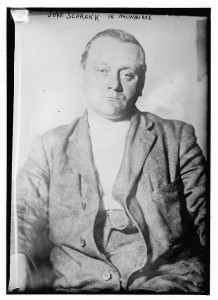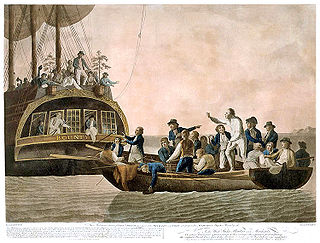03.05
John Schrank and the failed assassination of Theodore Roosevelt
During a stop in Milwaukee on his 1912 “Bull Moose” campaign for the presidency, former President Theodore Roosevelt was shot at close range by John Schrank (was born on March 5, 1876 in Germany), a psychotic New York saloonkeeper. Schrank had his .38 caliber pistol aimed at Roosevelt’s head, but a bystander saw the gun and deflected Schrank’s arm just as the trigger was pulled. Roosevelt did not realize he was hit until someone noticed a hole in his overcoat. When Roosevelt reached inside his coat, he found blood on his fingers. Roosevelt was extremely lucky. He had the manuscript of a speech in his coat pocket, folded in two, and the bullet was slowed as it passed through it. He also had a steel spectacle case in his pocket, and the bullet deflected off of it, before entering Roosevelt’s chest.
Roosevelt was examined in a Milwaukee hospital, and then observed for 8 days in a Chicago hospital. He was discharged on October 23, 1912, only a few days before the election. The bullet had effectively stopped Roosevelt’s campaign. He finished second to Woodrow Wilson, but ahead of the incumbent President, William Howard Taft. The bullet was never removed, and caused no difficulty after the wound healed.
Schrank, who had stalked Roosevelt all over the country, was never tried for the assault. He said he was motivated to shoot Roosevelt after a dream: I saw President McKinley sit up in his coffin pointing at a man in monk’s attire in whom I recognized Theodore Roosevelt. The dead president said, “This is my murderer, avenge my death.” Schrank was committed to the Central State Mental Hospital in Waupun, Wisconsin, where he remained until his death on September 15, 1943. In more than 30 years of confinement, he never received a visitor or a letter and his body was donated to Marquette University for medical study.
John Adams, last surviving mutineer of the HMS Bounty
John Adams was born on December 4, 1767 and was the last survivor of the HMS Bounty mutineers. The mutineers of Bounty settled on the Tahitian island of Pitcairn and set fire to the Bounty. Although the settlers were able to survive by farming and fishing, the initial period of settlement was marked by serious tensions among the settlers. Alcoholism, murder, disease and other ills had taken the lives of most of the mutineers and Tahitian men. He died on March 3, 1829.













